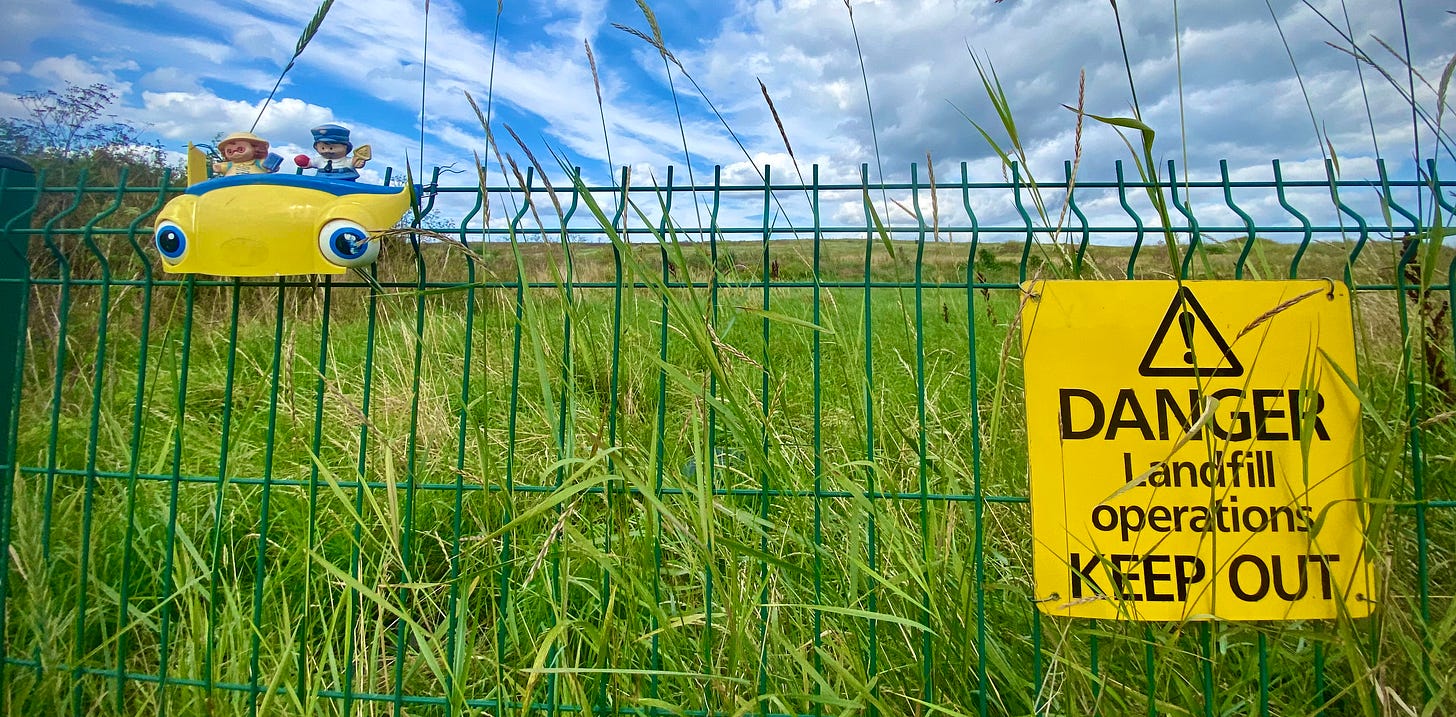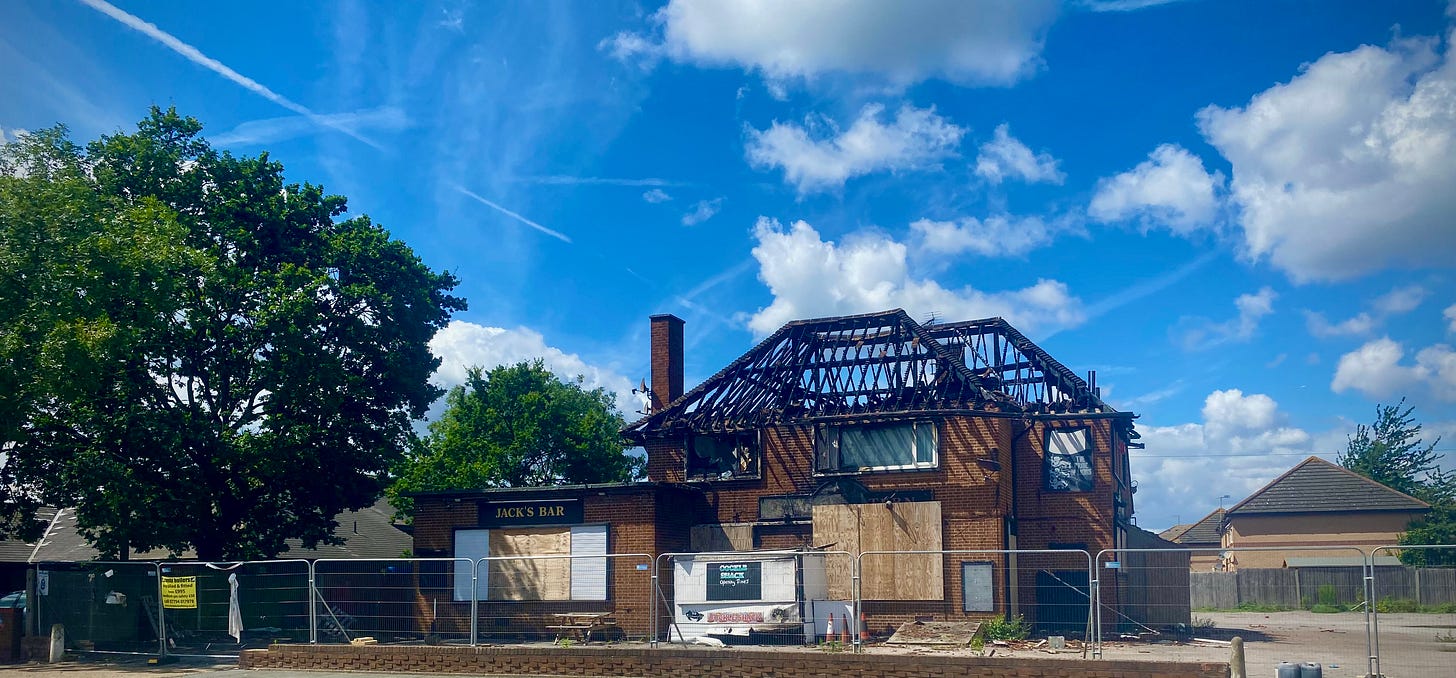How to Build a Future that Nobody Wants
May 2023. Britain's Labour Party announce that, if elected, they will allow home-building on Green Belt land, part of a campaign to construct hundreds of thousands of new houses.
Political parties in Britain keep saying we must build more houses. The figures are terrifying. No one dare say ‘build tower blocks’, because we tried that in the 1960s and the results were not good. Keep this rate of construction up and the logical conclusion is that the entire country will be one gigantic urban sprawl. At least in the post-war period planners built new towns, with facilities like schools, shops and pubs. Now they build housing estates that land just under the legal limit for those added extras.
If you would like to see where all this development might lead I suggest a visit to the lands east of London. Essex, you see, is the future.
During July 2020 I took part in a 500-mile walk along the English coast, starting at the most easterly town, Lowestoft, and then tramping our way south to the finish line on the Thames Estuary, east of London. There were three of us who did the entire hike - Ali, John and myself - but each day we would be joined by locals. Towards the end of that epic hike, we reach the M25, London's ring road.
South Ockenden is not on any tourist radar for the United Kingdom. When I arrived last night, in torrential rain, it looked distressingly horrible. The road had become a huge puddle and local youths came tumbling out the pub to stand next to it and get drenched by passing cars. You could tell that entertainment didn't get much better than that in South Ockenden. Every building looked in need of basic repairs. Every inhabitant looked in need of basic repairs. I was heading that way.
In the morning sunshine, South Ockenden does not look as bad as it did last night. This is a place that went from a population of a few hundred before WW1 to around 22,000 now and the planners did their very best to make a good job of it. We walk out through broad streets, admiring the way those planners included sweet chestnut and cherry trees at every opportunity along the lines of austere brown brick blocks. It is not their fault that the only pub seems to have burned down. In one back street of a 1960s housing estate we come across a venerable weatherboarded house behind an antique brick wall. It has spiralling chimneys that look Elizabethan and a mulberry tree that looks equally ancient. This former hunting lodge is the last remaining satellite building from a stately home that once stood a few miles away across a park.
A voice pipes up next to me. "Lovely, innit?"
Annette has lived next door to this lost treasure of a building for 55 years. Her own house is one of the those 1960s semi-detached places.
She explains how the lodge was once part of a great estate that stretched for miles to the west. I look down the end of her road and see a grassy hill.
"That was once farmland wiv 'orses on it," says Annette, "We'd go down and collect mushrooms and blackberries."
"It still looks nice."
She laughs. "It's a landfill site."
As for the Elizabethan lodge, the owner could not find a buyer: its gorgeous historical and architectural value was tarnished by the proximity of the council house estate.
"They sub-divided it," Annette tells me. "They had trouble sellin' it."
Walking on, we enter deep woodland where the peace and tranquility are only disturbed by the sound of thousands of heavy goods vehicles thundering past. The M25 is ahead. On our right is a stagnant ribbon of water, rapidly disappearing as it fills with algae and fallen trees. This was once a Capability Brown park. He had come down to the grand house of Belhus in 1754 to redesign the gardens and put in his signature serpentine lake. Across this gem the M25 was built. I push through the undergrowth and sit for a few minutes alone by his lake. Nothing stirs the covering of pond weed. At this time of year it should be alive with tadpoles emerging as frogs, but I can see no sign of life at all.
On the far side there are more signs of Brown's work, now a park with adventure playground. On a bench I spot an old man wearing head phones and tapping his feet furiously. What's he listening to? "Buddy Holly. Can't beat the oldies - they're the best."
I cannot disagree with that.
How could they destroy a Capability Brown park to host a motorway? A look at the map gives the answer: it was in the way. Planning for the M25 route had begun in the 1940s but it was not until the 1960s that anyone really began to imagine a vast ring of tarmac encircling London. Even then, no planning application ever stated that objective; each section was done as an individual project. The logic was always the same: given projected increases in road traffic numbers, the only answer is a new, bigger, road. In 1986 Margaret Thatcher opened the final section and...Lo! the capital was safely encased in a ring of concrete, tarmac and cars.
In those boom years before the crash of 1988, there were reports of illegal night-time supercar races around the entire circle and a 'lap record' of 45 minutes. That would give an average speed of 156mph. By 2018 the Department of Transport was reporting that most motorists were lucky to achieve an average of 25mph which is approximately the speed of a bicycle.
The road was deemed inadequate. A joke circulated that it was "Europe's biggest car park". The planners answer, you already know, was the make it bigger. A fourth lane was added for most of it, and then in some sections, a fifth. Drive around it now and you find yourself wondering about a couple more.
In Belhus Park I fall into step with local lady, Serena. "Our villages - lovely traditional places like Fobbing and Horndon - they have been re-designated as towns - just so that they can build huge housing estates around them."
Fobbing is a name that I remember from the history books. In 1381 its residents, and no doubt those of South Ockenden, rose up in fury against the king and marched on London. They were joined by thousands of others from all over Essex and Kent. King Richard II was terrified and ready to bolt, but the Mayor of London, William Walworth steadied him. The rebels were called to an open-air meeting at Smithfield where their leader, Watt Tyler, rode forwards to greet the king. Walworth then stabbed him several times, killing him. The revolt collapsed. Everyone went home.
Serena points out some nearby hills. "It's getting to the point where all our green space is landfill. That's the only space they can't build on. Small mercies!"
She will move soon: maybe down to Jaywick, or maybe to the Cotswolds. "Lots of people are going there from Essex"
Later in the day, I begin to see what Serena is talking about. Vast new warehouses, new roads, new housing estates: concrete and tarmac covering everything. No one local could ever have voted for this: it looks like the outside world imposing itself.
We walk into Rainham and I spot a shop called 'Coldblooded Reptile Centre'. Inside, finally, I spot reptiles, in glass boxes. The assistant tells me sales have boomed in the pandemic. "The Bearded Dragons are very popular," he tells me. "They're good with children."
Back outside I cross the railway and chat to a lady who works on costumes for the Royal Opera House.
What are you working on now, I ask.
"I do revivals," she says, "The next one is Romeo and Juliet."
"Oh, who wrote that?" I ask cheekily.
"Shakespeare." she says seriously.
"I didn't realise he did opera."
But she doesn’t want to joke. "It's a ballet," she says.
We emerge from a the clutter of the town on the bank of the River Thames, a great sliver of silver that comes from far away in the west. We turn downstream, heading past the landfill barges and their jetty. I drop far behind the group, walking alone along the bank. A little further on I'm stopped by an old man.
"You seen someone fishin' up there - on the jetty?"
I haven't.
"Where is that old bugger? He's supposed to meet for high tide."
Do you catch much?
"Whiting and bass, sometimes a Dover sole."
Eat them?
"Too right. Dover sole, innit?"
Away to the left the landfill is frothing with gulls having their supper of chicken bones and microbead plastics. Suddenly a lizard skitters across the path and into the weeds that fringe the landfill.
It takes less than a second and I cannot be sure, but it looked a lot like a bearded dragon.
In 2025 our 500-mile coastal walk will be extended to a project to walk the entire coast of Britain. Check out more details - and consider taking part.








This story is rather depressing as it hits close to home. Your tale of the polluted Ganges a while back tugged at the same chords.
Urban sprawl. Overpopulation. Destruction of nature. Pollution. Even an ocean away, it seems it’s the same effect the world over.